Radiation Effect in Ti-Cr Multilayer-Coated Silicon Carbide under Silicon Ion Irradiation up to 3 dpa
Abstract
:1. Introduction
2. Experimental Procedure
2.1. Coating Designs
2.2. Specimens
2.2.1. Ti-Cr Multilayer Coated SiC Specimens
2.2.2. Ti and Cr Bulk Specimens
2.3. Ion Irradiation and Analyses
2.3.1. Ion Irradiation
2.3.2. Swelling Evaluation
2.3.3. Microstructural Analyses of Ti-Cr Multilayer Coating
3. Results
3.1. Step Height and Swelling
3.2. Microstructural Analyses of Ti-Cr Multilayer Coating
3.2.1. SEM-EDS Analysis
3.2.2. TEM-EDS Analysis
4. Discussion
4.1. Swelling
4.2. Stress in Coating
5. Conclusions
- Measurement of swelling in pure Ti, pure Cr, and SiC revealed that the maximum tensile strain equivariant of the swelling difference might be generated in the coating on the SiC substrate by irradiation corresponding to 1 dpa for SiC;
- No delamination and cracking were observed in cross-sectional specimens of the coated SiC irradiated up to 3 dpa, although it had experienced the maximum tensile strain condition;
- According to analyses using TEM-EDS, large void formation and cascade mixing due to irradiation were not observed in the coating. The swelling in the coating irradiated at 573 K was presumed to be caused by other mechanisms such as point defects rather than void formation.
Author Contributions
Funding
Institutional Review Board Statement
Informed Consent Statement
Data Availability Statement
Acknowledgments
Conflicts of Interest
References
- The Fukushima Daiichi Accident; International Atomic Energy Agency: Vienna, Austria, 2015.
- Zinkle, S.J.; Terrani, K.A.; Gehin, J.C.; Ott, L.J.; Snead, L.L. Accident tolerant fuels for LWRs: A perspective. J. Nucl. Mater. 2014, 448, 374–379. [Google Scholar] [CrossRef]
- Ishibashi, R.; Ikegawa, T.; Noshita, K.; Kitou, K.; Kamoshida, M. Hydrogen explosion prevention system using SiC fuel cladding for large scale BWRs with inherently safe technologies. Mech. Eng. J. 2016, 3, 15-00215. [Google Scholar] [CrossRef] [Green Version]
- Ikegawa, T.; Kondo, T.; Sakamoto, K.; Yamashita, S. Performance Evaluation of Accident Tolerant Fuel Claddings during Severe Accidents of BWRs. In Proceedings of the TopFuel 2018, Prague, Czech Republic, 30 September–4 October 2018; European Nuclear Society: Brussels, Belgium, 2018. Paper No. A0131. [Google Scholar]
- Katoh, Y.; Terrani, K.A.; Snead, L.L. Systematic Technology Evaluation Program for SiC/SiC Composite-Based Accident-Tolerant LWR Fuel Cladding and Core Structures; ORNL/TM-2014/210; Oak Ridge National Laboratory: Oak Ridge, TN, USA, 2014. [Google Scholar]
- Terrani, K.A. Accident tolerant fuel cladding development: Promise, status, and challenge. J. Nucl. Mater. 2018, 501, 13–30. [Google Scholar] [CrossRef]
- State-of-the-Art Report on Light Water Reactor Accident-Tolerant Fuels; NEA No. 7317; OECD: Paris, France, 2018.
- Rohmer, E.; Martin, E.; Lorrette, C. Mechanical properties of SiC/SiC braided tubes for fuel cladding. J. Nucl. Mater. 2014, 453, 16–21. [Google Scholar] [CrossRef]
- Shapovalov, K.; Jacobsen, G.M.; Alva, L.; Truesdale, N.; Deck, C.P.; Huang, X. Strength of SiCf-SiCm composite tube under uniaxial and multiaxial loading. Trans. Am. Nucl. Soc. 2018, 120, 371–374. [Google Scholar] [CrossRef]
- Hinoki, T.; Kano, F.; Kondo, S.; Kawaharada, Y.; Tsuchiya, Y.; Lee, M.; Sakai, H. Development of liquid phase sintering silicon cabide composites for light water reactor. Coatings 2022, 12, 623. [Google Scholar] [CrossRef]
- Shimoda, K.; Hinoki, T.; Kishimoto, H.; Kohyama, A. Enhanced high-temperature performances of SiC/SiC composites by high densification and crystalline structure. Compos. Sci. Technol. 2011, 71, 326–332. [Google Scholar] [CrossRef]
- Katoh, Y.; Snead, L.L.; Cheng, T.; Shih, C.; Lewis, W.D.; Koyanagi, T.; Hinoki, T.; Henager, C.H., Jr.; Ferraris, M. Radiation-tolerant joining technologies for silicon carbide ceramics and composites. J. Nucl. Mater. 2014, 448, 497–511. [Google Scholar] [CrossRef]
- Ishibashi, R.; Takamori, Y.; Zhang, X.; Kondo, T.; Miyazaki, K. Development of Joining Technology Using Local Heating for SiC Fuel Cladding. In Proceedings of the Top Fuel 2016, Boise, ID, USA, 11–15 September 2016; American Nuclear Society: La Grange Park, IL, USA, 2016. Paper No. 17636. pp. 805–813. [Google Scholar]
- Khalifa, H.E.; Koyanagi, T.; Jacobsen, G.; Deck, C.P. Radiation stable, hybrid, chemical vaper infiltration/preceramic polymer joining of silicon carbide components. J. Nucl. Mater. 2017, 487, 91–95. [Google Scholar] [CrossRef]
- Deck, C.P.; Gonderman, S.; Jacobsen, G.M.; Sheeder, J.; Oswald, S.; Haefelfinger, R.; Shapovalov, K.S.; Khalifa, H.E.; Gazza, J.; Lyons, J.; et al. Overview of general atomics SiGAtm SiC-SiC composite development for accident toletrant fuel. Trans. Am. Nucl. Soc. 2019, 120, 371–374. [Google Scholar]
- Ishibashi, R.; Kida, M.; Shibata, M.; Kondo, T.; Yamashita, S.; Kawanishi, T.; Fukahori, T. Joining Technology with Corrosion Resistant Coating for Silicon-carbide Fuel Cladding. In Proceedings of the Top Fuel 2019, Seattle, WA, USA, 22–27 September 2019; American Nuclear Society: La Grange Park, IL, USA, 2019. Paper No. 29441. pp. 753–759. [Google Scholar]
- Shapovalov, K.; Jacobsen, G.M.; Shih, C.; Deck, C.P. C-ring testing of nuclear grade silicon carbide composites at temperatures up to 1900 °C. J. Nucl. Mater. 2019, 522, 184–191. [Google Scholar] [CrossRef]
- Pint, B.; Terrani, K.; Brady, M.; Cheng, T.; Keiser, J. High temperature oxidation of fuel cladding candidate materials in steam-hydrogen environements. J. Nucl. Mater. 2013, 440, 420–427. [Google Scholar] [CrossRef]
- Terrani, K.A.; Bruce, P.; Parish, C.; Silva, C.; Snead, L.; Katoh, Y. Silicon carbide oxidation in steam up to 2 MPa. J. Am. Ceram. Soc. 2014, 97, 2331–2352. [Google Scholar] [CrossRef]
- Pham, H.; Nagae, Y.; Kurata, M.; Bottomley, D.; Furumoto, K. Oxidation kinetics of silicon carbide in steam at temperature range of 1400 to 1800 °C studied by laser heating. J. Nucl. Mater. 2020, 529, 151939. [Google Scholar] [CrossRef]
- Avincola, V.; Grosse, M.; Stegmaier, U.; Steinbrueck, M.; Seifert, H. Oxidation at high temperatures in steam atmosphere and quench of silicon carbide composites for nuclear application. Nucl. Eng. Des. 2015, 195, 468–478. [Google Scholar] [CrossRef]
- Pham, H.V.; Kurata, M.; Steinbrueck, M. Steam Oxidation of Silicon Carbide at High Temperatures for Application as Accident Tolerant Fuel Cladding, an Overview. Thermo 2021, 1, 151–167. [Google Scholar] [CrossRef]
- Terrani, K.A.; Yang, Y.; Kim, Y.J.; Rebak, R.; Meyer, H.M.; Gerczak, T.J. Hydrothermal corrosion of SiC in LWR coolant environments in the absence of irradiation. J. Nucl. Mater. 2015, 465, 488–498. [Google Scholar] [CrossRef] [Green Version]
- Pantano, M.A.; McKrell, T.J.; Guenoun, P.B.; Kazimi, M.S.; Carpenter, D.M.; Kohse, G.E. Silicon Carbide Behavior Under Prototypic LWR Chemistry/Neutron Flux and Accident Conditions, Accident Tolerant Fuel Concepts for Light Water Reactors; IAEA-TECDOC-1797; International Atomic Energy Agency: Vienna, Austria, 2016; pp. 334–350. [Google Scholar]
- Parish, C.M.; Terrani, K.A.; Kim, Y.-J.; Koyanagi, T.; Katoh, Y. Microstructure and hydrothermal corrosion behavior of NITE-SiC with various sintering additives in LWR coolant environments. J. Eur. Ceram. Soc. 2017, 37, 1261–1279. [Google Scholar] [CrossRef] [Green Version]
- Doyle, P.J.; Raiman, S.S.; Rebak, R.; Terrani, K.A. Characterization of the hydrothermal corrosion behavior of ceramics for accident tolerant fuel cladding. In Proceedings of the 18th International Conference on Environmental Degradation of Materials—Water Reactors, Portland, OR, USA, 13–17 August 2017; The Minerals, Metals & Materials Society: Pittsburgh, PA, USA, 2018; pp. 269–280. [Google Scholar]
- Doyle, P.J.; Zinkle, S.; Raiman, S.S. Hydrothermal corrosion behavior of CVD SiC in high temperature water. J. Nucl. Mater. 2020, 539, 152241. [Google Scholar] [CrossRef]
- Doyle, P.; Sun, K.; Snead, L.; Katoh, Y.; Bartels, D.; Zinkle, S.; Raiman, S. The effects of neutron and ionizing irradiation on the aqueous corrosion of SiC. J. Nucl. Mater. 2020, 536, 152190. [Google Scholar] [CrossRef]
- Kondo, S.; Mouri, S.; Hyodo, Y.; Hinoki, T.; Kano, F. Role of irradiation-induced defects on SiC dissolution in hot water. Corros. Sci. 2016, 112, 402–407. [Google Scholar] [CrossRef]
- Kondo, S.; Lee, M.; Hinoki, T.; Hyodo, Y.; Kano, F. Effect of irradiation damage on hydrothermal corrosion of SiC. J. Nucl. Mater. 2015, 464, 36–42. [Google Scholar] [CrossRef]
- Shin, J.H.; Kim, D.; Lee, H.J.; Lee, H.-G.; Park, J.Y.; Kim, W.-J. Factors affecting the hydrothermal corrosion behavior of chemically vaper deposited silicon carbides. J. Nucl. Mater. 2019, 518, 350–356. [Google Scholar] [CrossRef]
- Csontos, A.; Capps, N. Accident-Tolerant Fuel Valuation: Safety and Economic Benefits (Revision 1); EPRI Technical Report 3002015091; Electric Power Research Institute: Palo Alto, CA, USA, 2019. [Google Scholar]
- AESJ-SC-S007:2019; The Standards of the Atomic Energy Society of Japan, Water Chemistry Guidelines for Boiling Water Reactors: 2019. Atomic Energy Society of Japan: Tokyo, Japan, 2019. (In Japanese)
- Hirayama, H.; Kawakubo, T.; Goto, A.; Kaneko, T. Corrosion behavior of silicon carbide in 290 °C water. J. Am. Ceram. Soc. 1989, 72, 2049–2053. [Google Scholar] [CrossRef]
- Kim, W.-J.; Hwang, H.S.; Park, J.Y. Corrosion behavior of reaction-bonded silicon carbide ceramics in high-temperature water. J. Mater. Sci. Lett. 2002, 21, 733–735. [Google Scholar] [CrossRef]
- Kim, W.-J.; Hwang, H.S.; Park, J.Y.; Ryu, W.-S. Corrosion behaviors of sintered and chemically vapor deposited silicon carbide ceramics in water at 360 °C. J. Mater. Sci. Lett. 2003, 22, 581–584. [Google Scholar] [CrossRef]
- Ang, C.K.; Terrani, K.A.; Burns, J.; Katoh, Y. Examination of Hybrid Metal Coatings for Mitigation of Fission Product Release and Corrosion Protection of LWR SiC/SiC; ORNL/TM-2016/332; Oak Ridge National Laboratory: Oak Ridge, TN, USA, 2016. [Google Scholar]
- Ang, C.; Katoh, Y.; Kemary, C.; Kiggans, J.O.; Terrani, K.A. Chromium-based mitigation coatings on SiC materials for fuel cladding. Trans. Am. Nucl. Soc. 2016, 114, 1095–1097. [Google Scholar]
- Raiman, S.S.; Doyle, P.; Ang, C.; Katoh, Y.; Terrani, K.A. Hydrothermal corrosion of coatings on silicon carbide in boiling water reactor conditions. Corrosion 2019, 75, 217–223. [Google Scholar] [CrossRef]
- Raiman, S.S.; Ang, C.; Doyle, P.; Terrani, K.A. Hydrothermal Corrosion of SiC Materials for Accident Tolerant Fuel Cladding with and Without Mitigation Coatings. In Proceedings of the 18th International Conference on Environmental Degradation of Materials in Nuclear Power Systems—Water Reactors, Portland, OR, USA, 13–17 August 2017; The Minerals, Metals & Materials Society: Pittsburgh, PA, USA, 2018; pp. 259–267. [Google Scholar]
- Doyle, P.J.; Raiman, S.S.; Ang, C.; Katoh, Y.; Zinkle, S. Evaluation of the Corrosion Kinetics of SiC with and without Mitigation Coatings in LWR Chemistries. In Proceedings of the 19th International Conference on Environmental Degradation of Materials in Nuclear Power Systems—Water Reactors, Boston, MA, USA, 18–22 August 2019; The American Nuclear Society: La Grange Park, IL, USA, 2019; pp. 417–427. [Google Scholar]
- Raiman, S.S.; Doyle, P.J.; Ang, C.; Koyanagi, T.; Carpenter, D.; Terrani, K.A.; Katoh, Y. Irradiation-induced Cracking of Dual-purpose Coatings on SiC. In Proceedings of the 18th International Conference on Environmental Degradation of Materials in Nuclear Power Systems—Water Reactors, Boston, MA, USA, 18–22 August 2019; The American Nuclear Society: La Grange Park, IL, USA, 2019; pp. 428–433. [Google Scholar]
- Doyle, P.J.; Doyle, P.J.; Koyanagi, T.; Ang, C.; Snead, L.; Mouche, P.; Katoh, Y.; Raiman, S.S. Evaluation of the effects of neutron irradiation on first-generation corrosion mitigation coatings on SiC for accident-tolerant fuel cladding. J. Nucl. Mater. 2020, 536, 152203. [Google Scholar] [CrossRef]
- Quillin, K.; Yeom, H.; Dabney, T.; McFariand, M.; Sridharan, K. Experimental evaluation of direct current magnetron sputtered and high-power impulse magnetron sputtered Cr coatings on SiC for light water reactor applications. Thin Solid Films 2020, 716, 138431. [Google Scholar] [CrossRef]
- Mouche, P.A.; Evans, A.; Zhong, W.; Koyanagi, T.; Katoh, Y. Effects of sample bias on adhesion of magnetron sputtered Cr coatings on SiC. J. Nucl. Mater. 2021, 556, 153251. [Google Scholar] [CrossRef]
- Kain, K.A.; Stack, P.I.M.; Mouche, P.A.; Pillai, R.R.; Pint, B.A. Steam oxidation of chromium corrosion barrier coatings for sic-based accident tolerant fuel cladding, J. Nucl. Mater. 2021, 543, 152561. [Google Scholar] [CrossRef]
- Ishibashi, R.; Tanabe, S.; Kondo, T.; Yamashita, S.; Nagase, F. Improving the Corrosion Resistance of Silicon Carbide for Fuel in BWR Environments by Using a Metal Coating. In Proceedings of the WRFPM 2017, Jeju Island, Korea, 10–14 September 2017; Korean Nuclear Society: Daejeon, Korea, 2017. Paper No. A-177_F-177. [Google Scholar]
- Ishibashi, R.; Tanabe, S.; Kondo, T.; Yamashita, S.; Fukahori, T. Improvement of Corrosion Resistant Coating for Silicon-carbide Fuel Cladding in Oxygenated High Temperature Water. In Proceedings of the TopFuel 2018, Prague, Czech Republic, 30 September–4 October 2018; European Nuclear Society: Brussels, Belgium, 2018. Paper No. A0072. [Google Scholar]
- Ishibashi, R.; Ishida, K.; Kondo, T.; Watanabe, Y. Corrosion-resistant metallic coating on silicon carbide for use in high-temperature water. J. Nucl. Mater. 2021, 557, 153214. [Google Scholar] [CrossRef]
- Ishibashi, R.; Shibata, M.; Sasaki, M.; Kondo, T. Hydrothermal Corrosion Evaluation of Titanium-coated Silicon Carbide Tube with End-plug Joints in Oxygenated High Temperature Water. In Proceedings of the Top Fuel 2021, Santander, Spain, 24–28 October 2021; European Nuclear Society: Brussels, Belgium, 2021. No. 82. [Google Scholar]
- Yueh, K. SiC Composite for Fuel Structure Applications; DOE-EPRI-0000539; Electric Power Research Institute: Palo Alto, CA, USA, 2017. [Google Scholar]
- Ziegler, J.F.; Ziegler, M.D.; Biersak, J.P. SRIM—The stopping and range of ions in matter. Nucl. Instr. Meth. 2010, B 268, 1818–1823. [Google Scholar] [CrossRef] [Green Version]
- ASTM E521-16; Standard Practice for Investigating the Effects of Neutron Radiation Damage Using Charged-Particle Irradiation. ASTM International: West Conshohocken, PA, USA, 2016.
- Devanathan, R.; Weber, W.J.; Gao, F. Atomic scale simulation of defect production in irradiated 3C-SiC. J. Appl. Phys. 2001, 90, 2303–2309. [Google Scholar] [CrossRef]
- Snead, L.L.; Nozawa, T.; Katoh, Y.; Byun, T.S.; Kondo, S.; Petti, D.A. Handbook of SiC properties for fuel performance modeling. J. Nucl. Mater. 2007, 371, 329–377. [Google Scholar] [CrossRef]
- Seto, Y.; Ohtsuka, M. ReciPro: Free and open-source multipurpose crystallographic software integrating a crystal model database and viewer, diffraction and microscopy simulators, and diffraction data analysis tools. J. Appl. Cryst. 2022, 55, 397–410. [Google Scholar] [CrossRef]
- The Materials Project mp-72. Available online: https://materialsproject.org/materials/mp-72/ (accessed on 4 April 2022).
- The Materials Project mp-631. Available online: https://materialsproject.org/materials/mp-631/ (accessed on 4 April 2022).
- The Materials Project mp-1589. Available online: https://materialsproject.org/materials/mp-1589/ (accessed on 4 April 2022).
- The Materials Project mp-90. Available online: https://materialsproject.org/materials/mp-90/ (accessed on 4 April 2022).
- The Materials Project mp-729. Available online: https://materialsproject.org/materials/mp-729/ (accessed on 4 April 2022).
- AFLOW Prototype: A5B3_oC16_65_aeh_bj. Available online: https://aflow.org/material/?id=aflow:1016082d8a829e2f (accessed on 1 April 2022).
- AFLOW Prototype: AB_cF8_225_b_a. Available online: https://aflow.org/material/?iid=aflow:0e5c7dd4d4402dff (accessed on 18 May 2022).
- Jain, A.; Omg, S.P.; Hautier, G.; Chen, W.; Richards, W.D.; Dacek, S.; Cholia, S.; Gunter, D.; Skinner, D.; Ceder, G.; et al. The Materials Project: A materials genome approach to accelerating materials innovation. APL Mater. 2013, 1, 011002. [Google Scholar] [CrossRef] [Green Version]
- Hicks, D.; Mehl, M.J.; Esters, M.; Oses, C.; Levy, O.; Hart, G.L.W.; Toher, C.; Curtarolo, S. The AFLOW Library of Crystallographic Prototypes: Part 3. Comp. Mater. Sci. 2021, 199, 110450. [Google Scholar] [CrossRef]
- Du, Y.; Schuster, J.C.; Perring, L. Experimental investigation and thermodynamic description of the constitution of the ternary system Cr-Si-C. J. Am. Ceram. Soc. 2000, 83, 2067–2073. [Google Scholar] [CrossRef]
- Pellegrini, P.W.; Giessen, B.C.; Feldman, J.M. A survey of the Cr-rich area of the Cr-Si-C phase diagram. J. Electrochem. Soc. 1972, 119, 535–537. [Google Scholar] [CrossRef]
- Katoh, Y.; Snead, L.L.; Parish, C.M.; Hinoki, T. Observation and possible mechanism of irradiation induced creep in ceramics. J. Nucl. Mater. 2013, 434, 141–151. [Google Scholar] [CrossRef]
- Katoh, Y.; Ozawa, K.; Shih, C.; Nozawa, T.; Shinavski, R.J.; Hasegawa, A.; Snead, L.L. Continuous SiC fiber, CVI SiC matrix composites for nuclear applications: Properties and irradiation effects. J. Nucl. Mater. 2014, 448, 448–476. [Google Scholar] [CrossRef]
- Higashiguchi, Y.; Kayano, H.; Yajima, S. Relation between microstructure and recovery behavior in fast neutron irradiated titanium. J. Nucl. Sci. Technol. 1976, 13, 454–458. [Google Scholar] [CrossRef]
- Brumhall, J.L.; Kulcinski, G.L.; Kissinger, H.E.; Mastel, B. Microstructural analysis of neutron irradiated titanium and rhenium. Radiat. Eff. 1971, 9, 273–278. [Google Scholar] [CrossRef]
- Jostsons, A.; Black, R.C.; Kelly, P.M. Characterization of dislocation loops in neutron-irradiated titanium. Philos. Mag. A 1980, 41, 903–916. [Google Scholar] [CrossRef]
- Jouanny, E.; Doriot, S.; Malaplate, J.; Dehmas, M.; Allais, L.; Le Thuaut, M.; Millot, T. Evolution of defects in titanium grade 2 under Ti2+ ion irradiation. J. Microsc. 2017, 265, 275–286. [Google Scholar] [CrossRef] [Green Version]
- Kuprin, A.S.; Belous, V.A.; Voyevodin, V.N.; Vasilenko, R.L.; Ovcharenko, V.D.; Tolstolutskaya, G.D.; Kopanets, I.E.; Kolodiy, I.V. Irradiation resistance of vacuum arc chromium coatings for zirconium alloy fuel claddings. J. Nucl. Mater. 2018, 510, 163–167. [Google Scholar] [CrossRef]
- Ryabikovskaya, E.; French, A.; Gabriel, A.; Kim, H.; Wang, T.; Shirvan, K.; Garner, F.A.; Shao, L. Irradiation-induced swelling of pure chromium with 5 MeV Fe ions in the temperature range 450–650 °C. J. Nucl. Mater. 2021, 543, 152585. [Google Scholar] [CrossRef]
- 2.3.5 Thermal Expansion, Kaye and Laby Online. In Tables of Physical and Chemical Constants, 16th ed.; Version 1.0 (2005); The National Physical Laboratory: Middlesex, UK, 1995; Available online: www.kayelaby.npl.co.uk (accessed on 28 April 2022).
- 2.2.2 Elasticities and Strengths, Kaye and Laby Online. In Tables of Physical and Chemical Constants, 16th ed.; Version 1.0 (2005); The National Physical Laboratory: Middlesex, UK, 1995; Available online: www.kayelaby.npl.co.uk (accessed on 28 April 2022).

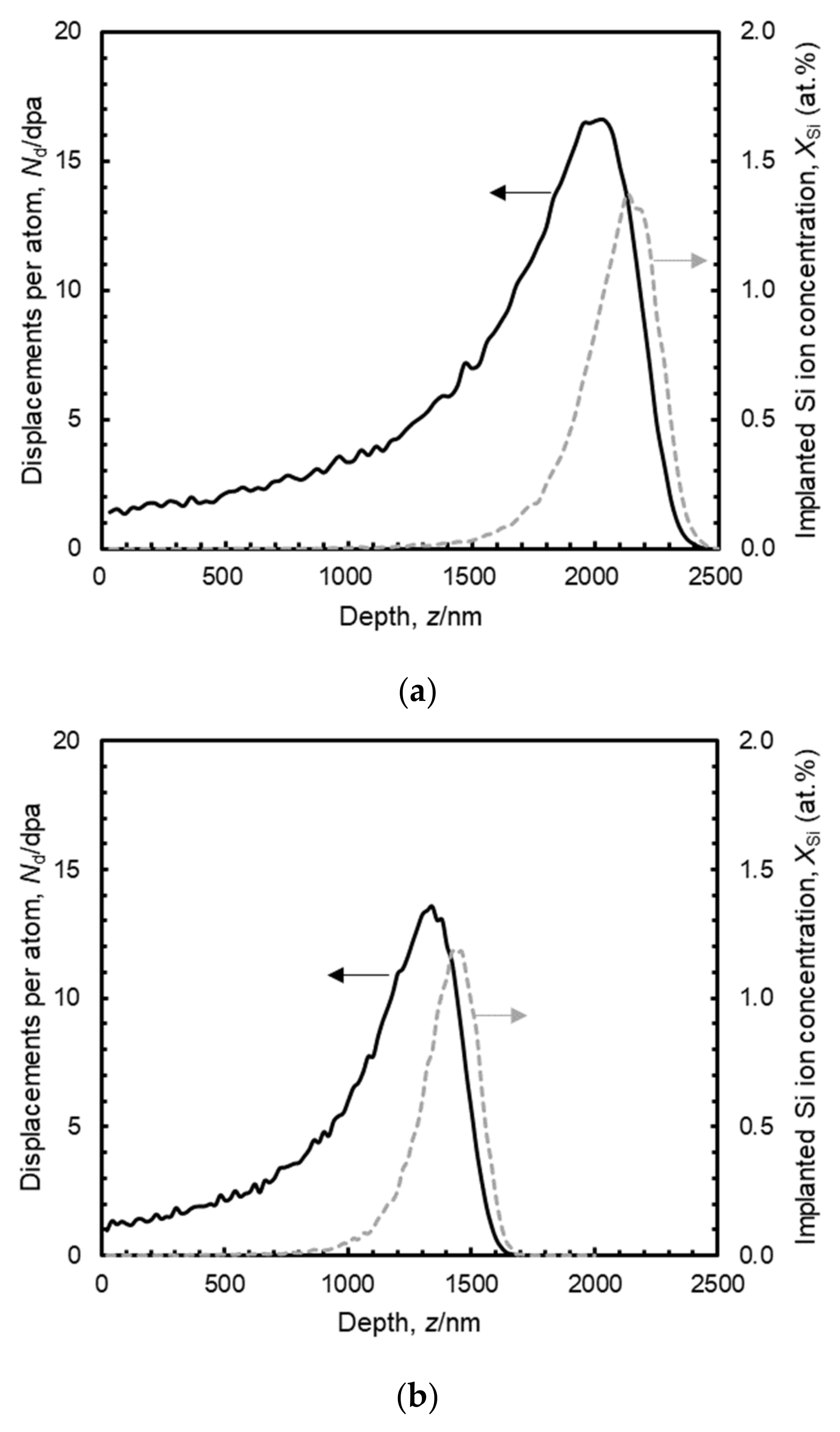



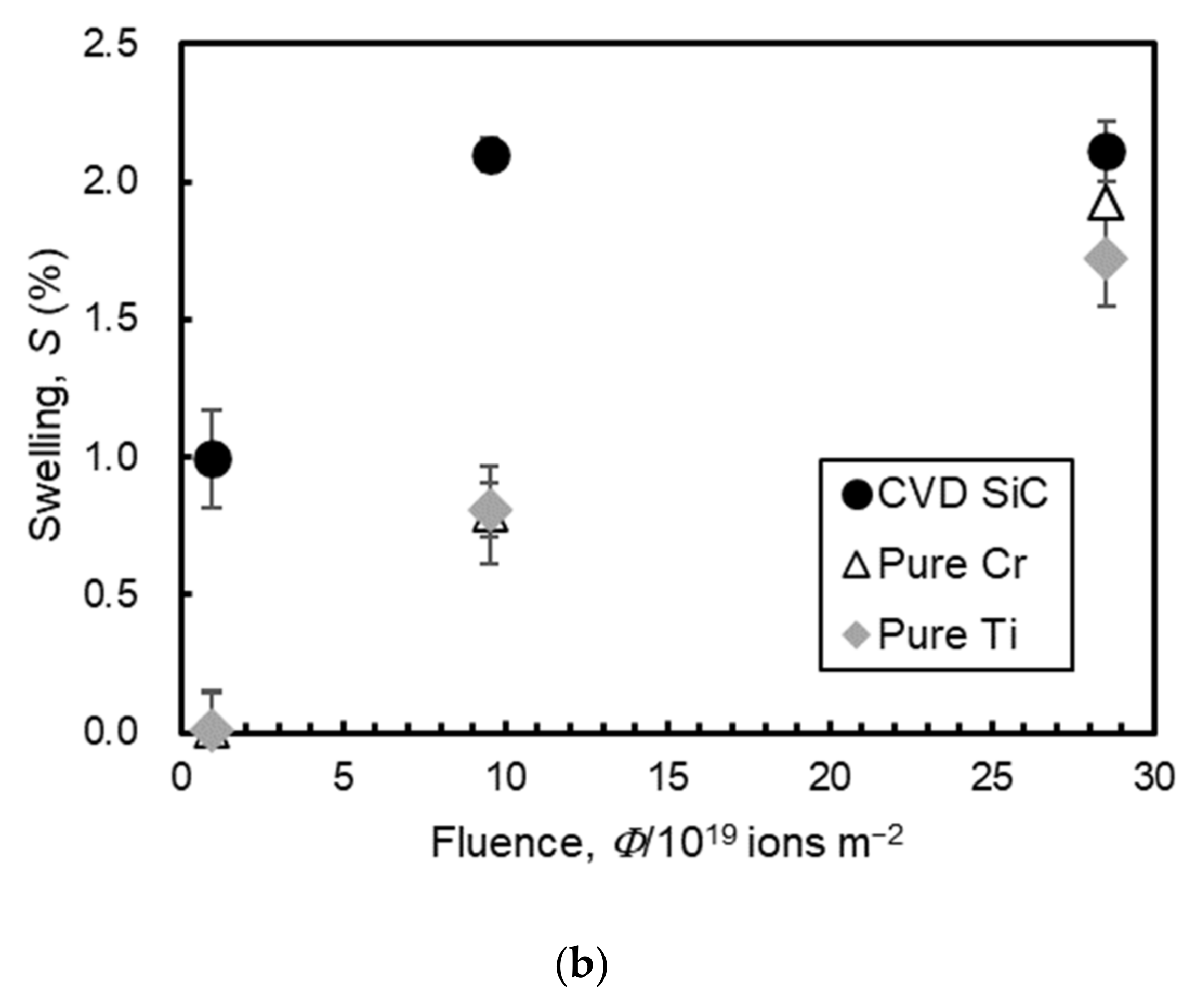
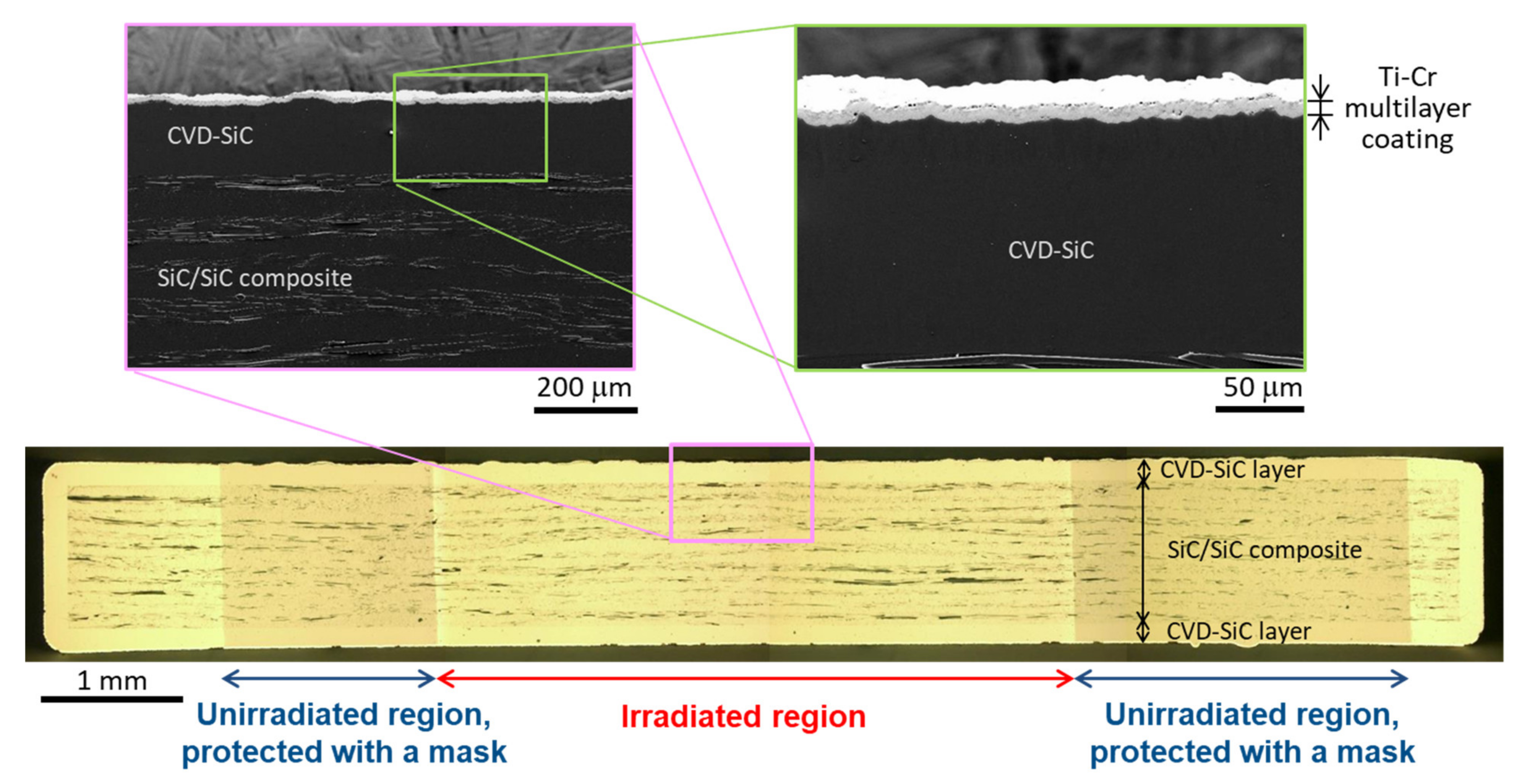
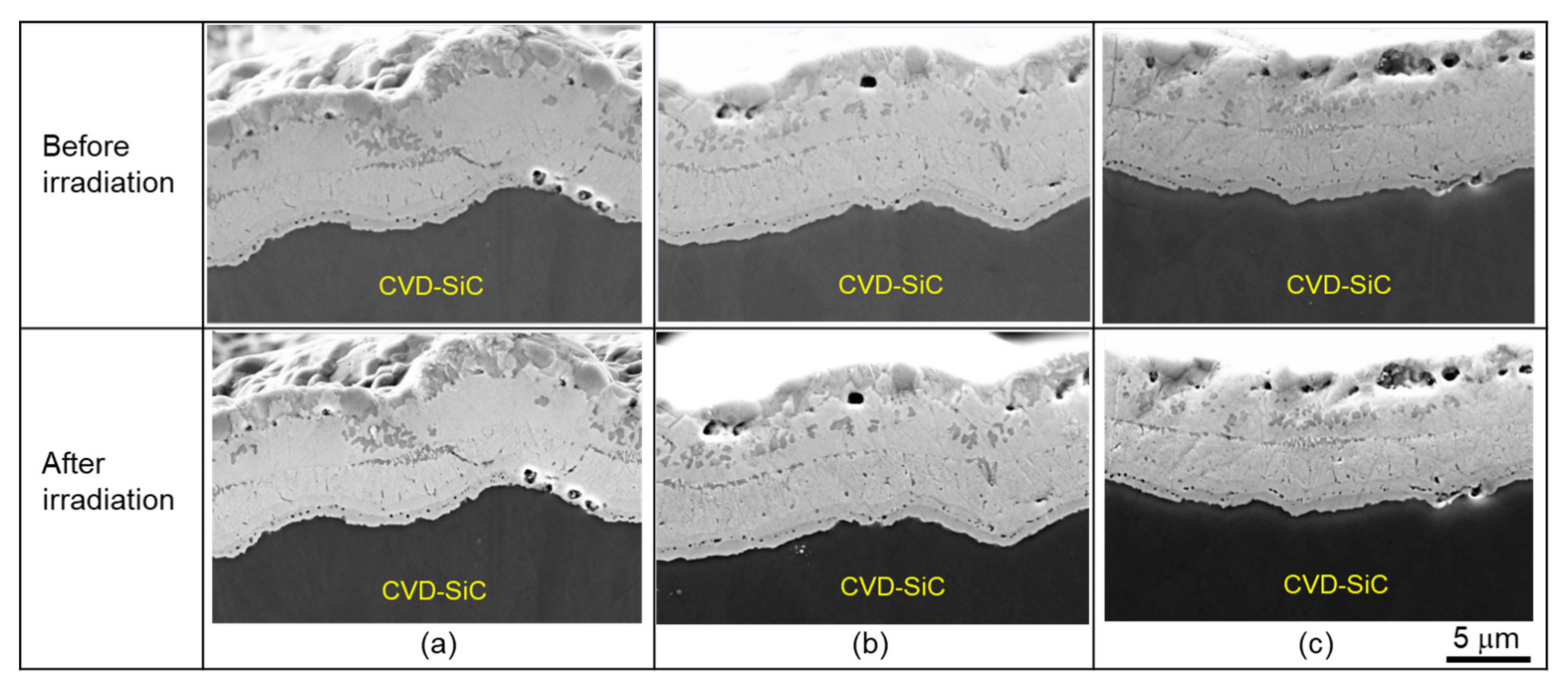
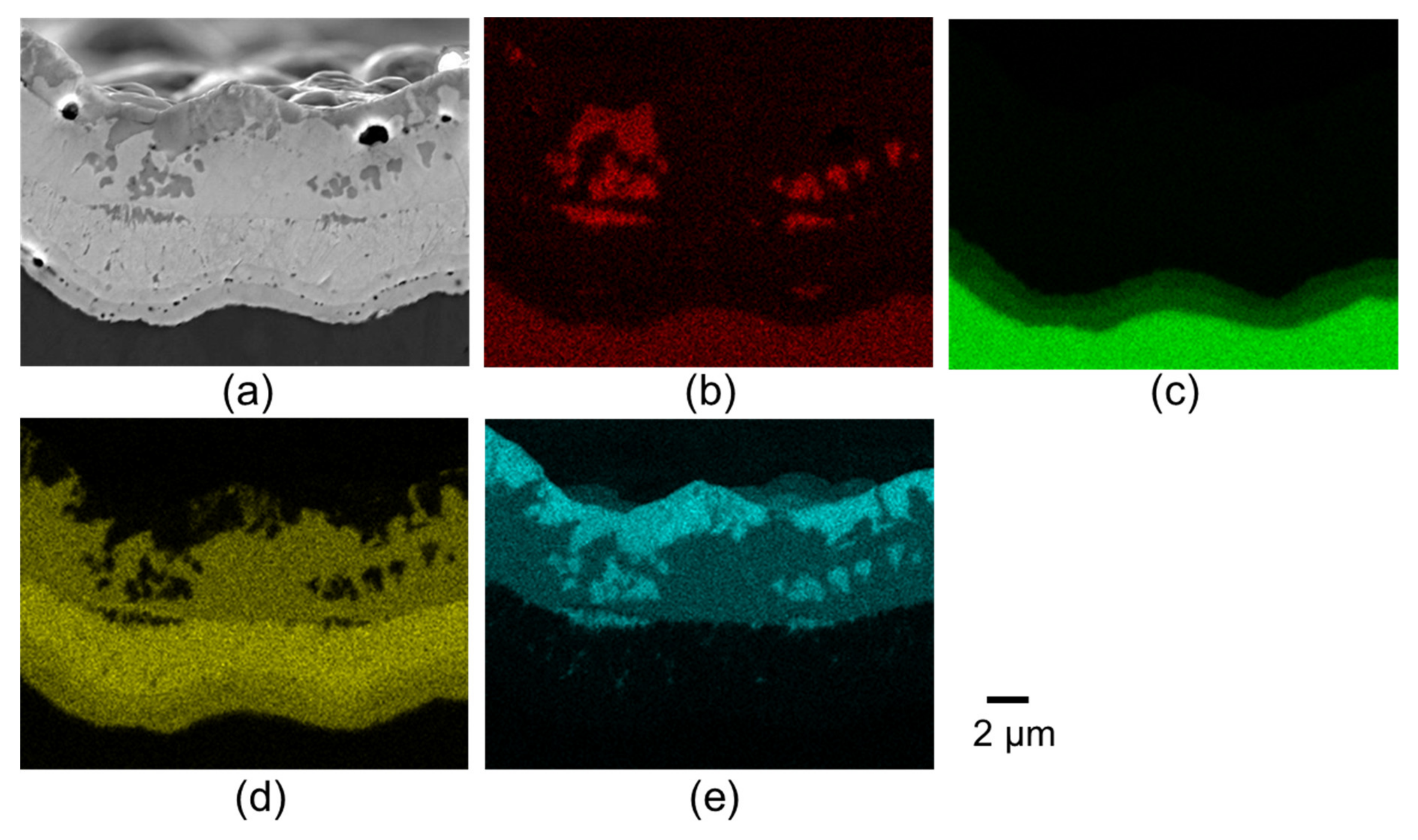
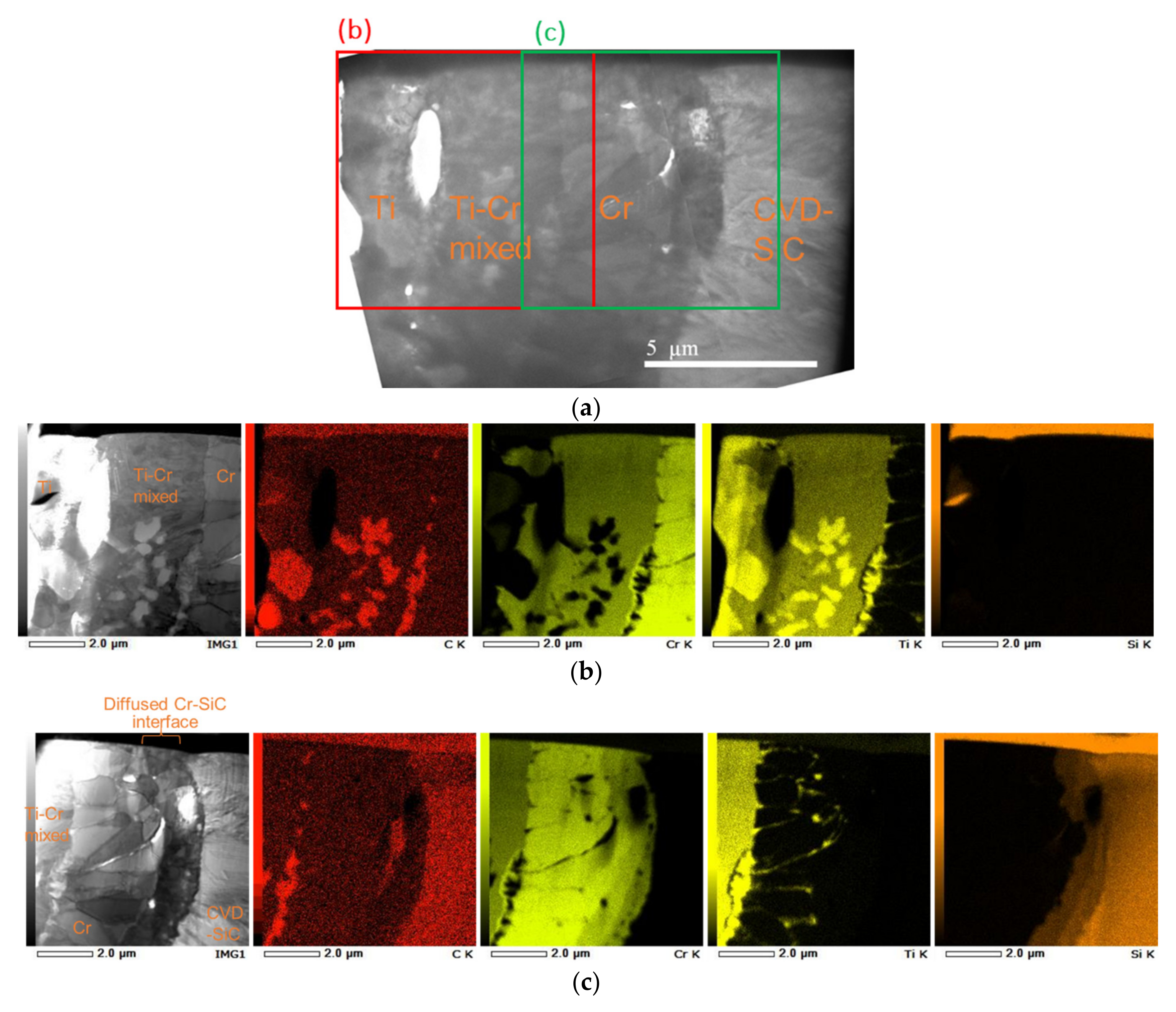
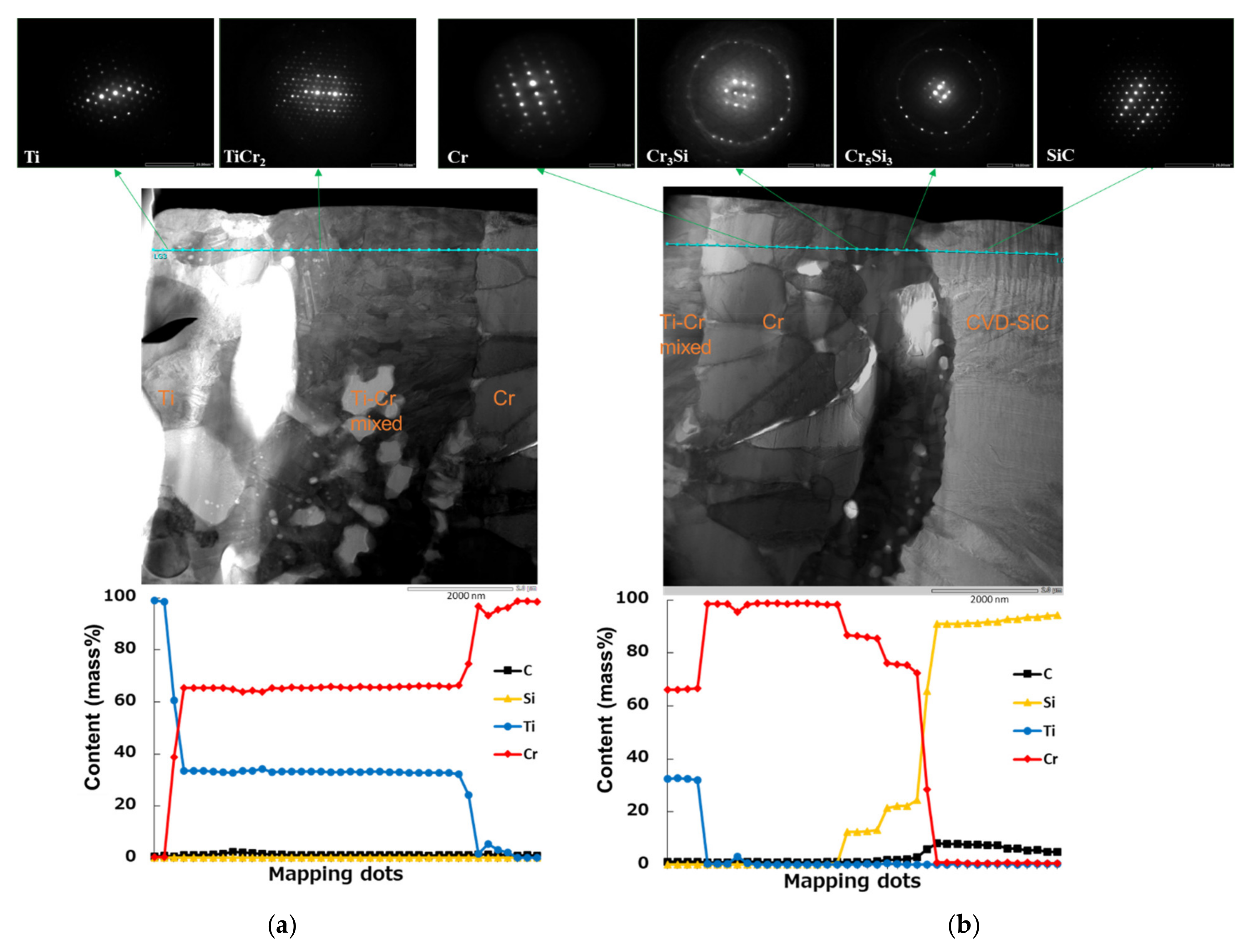
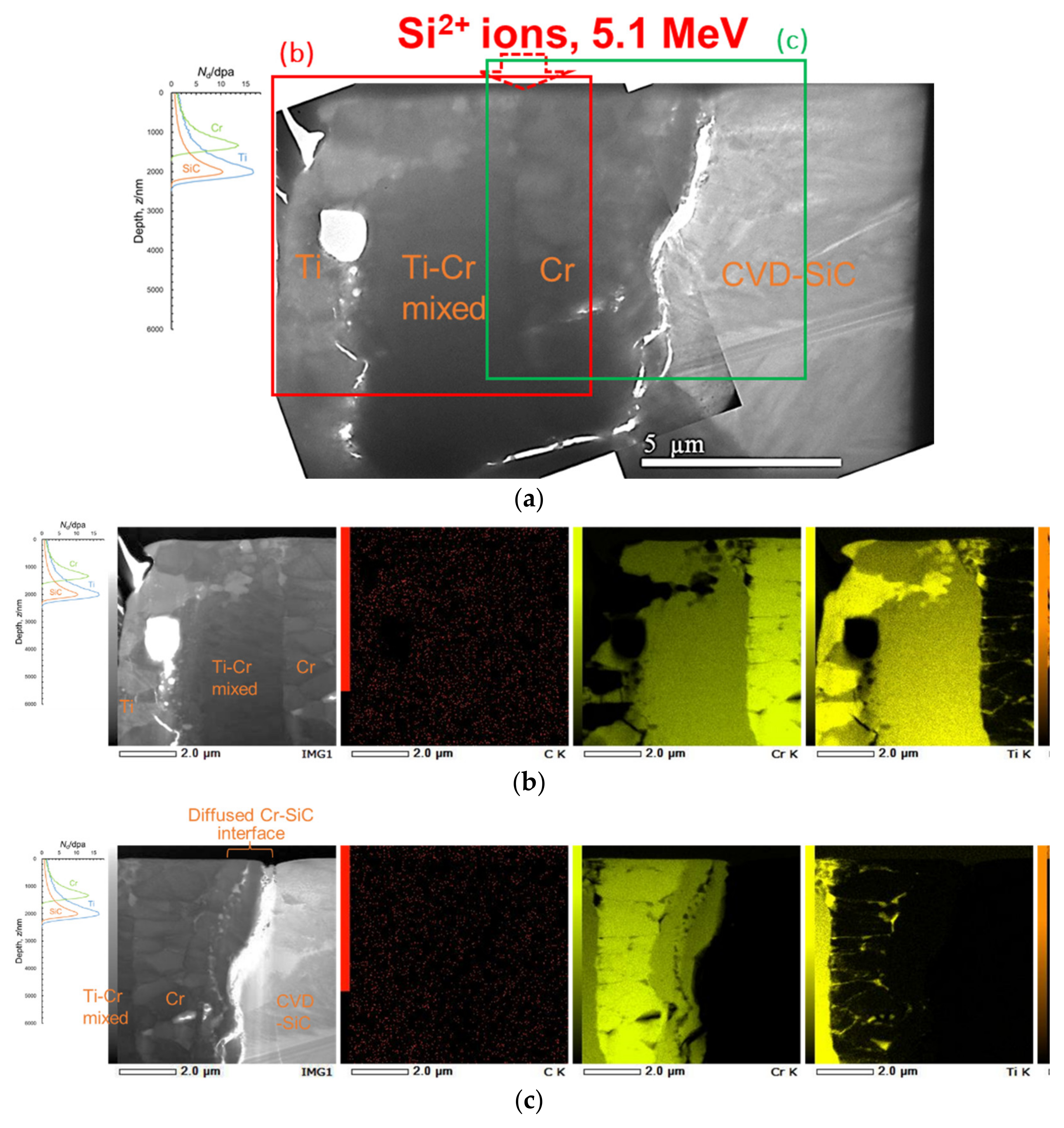
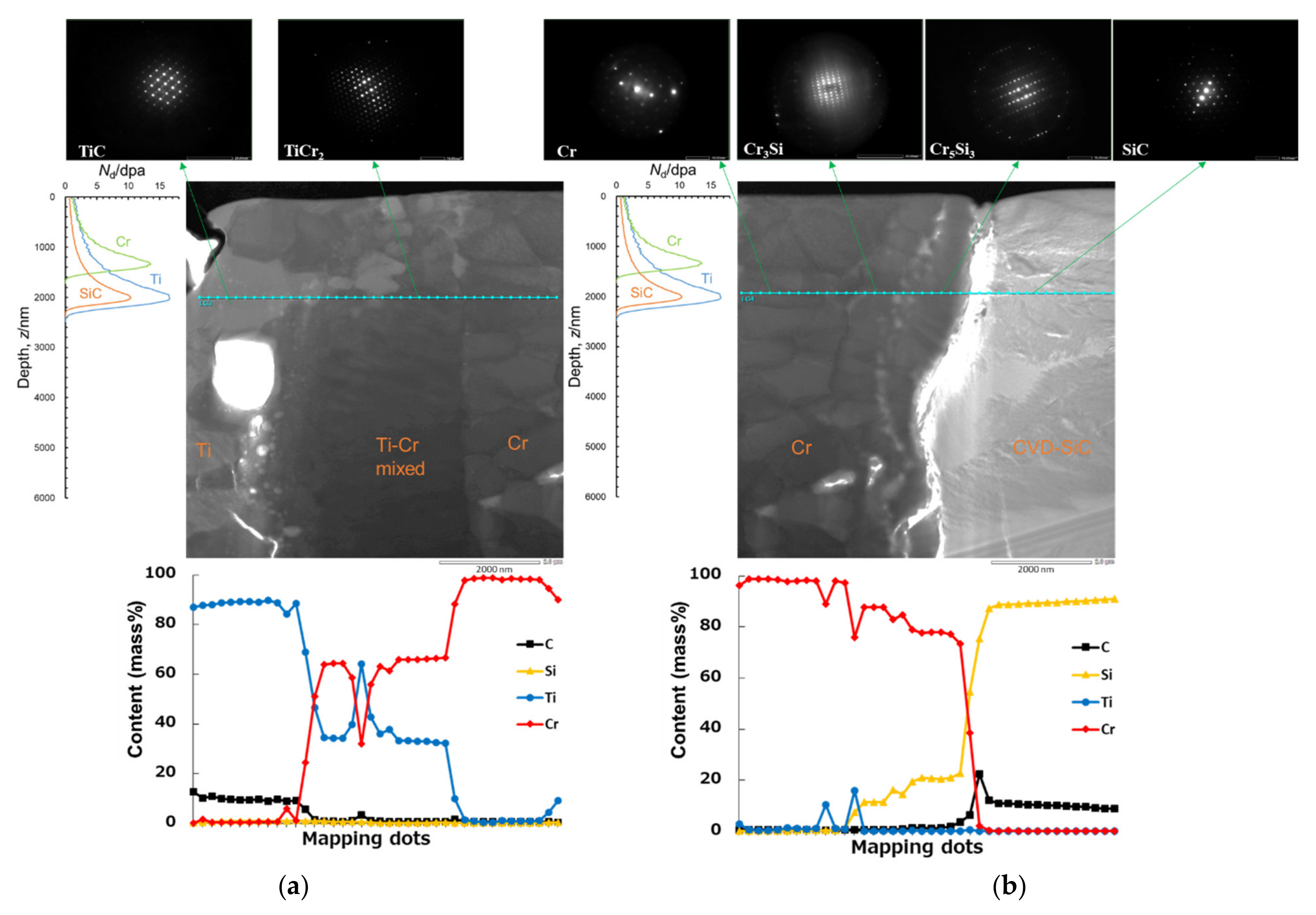


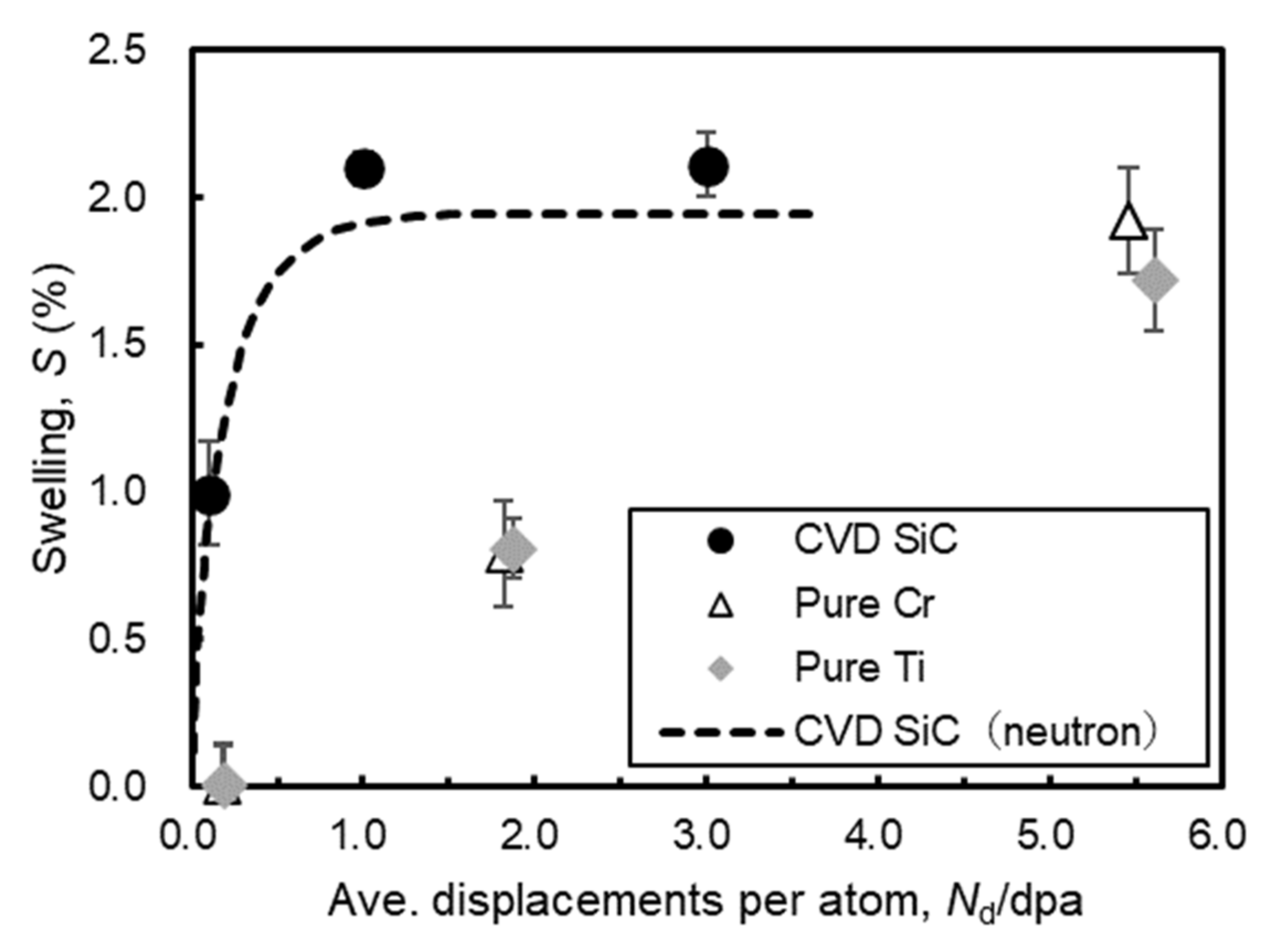
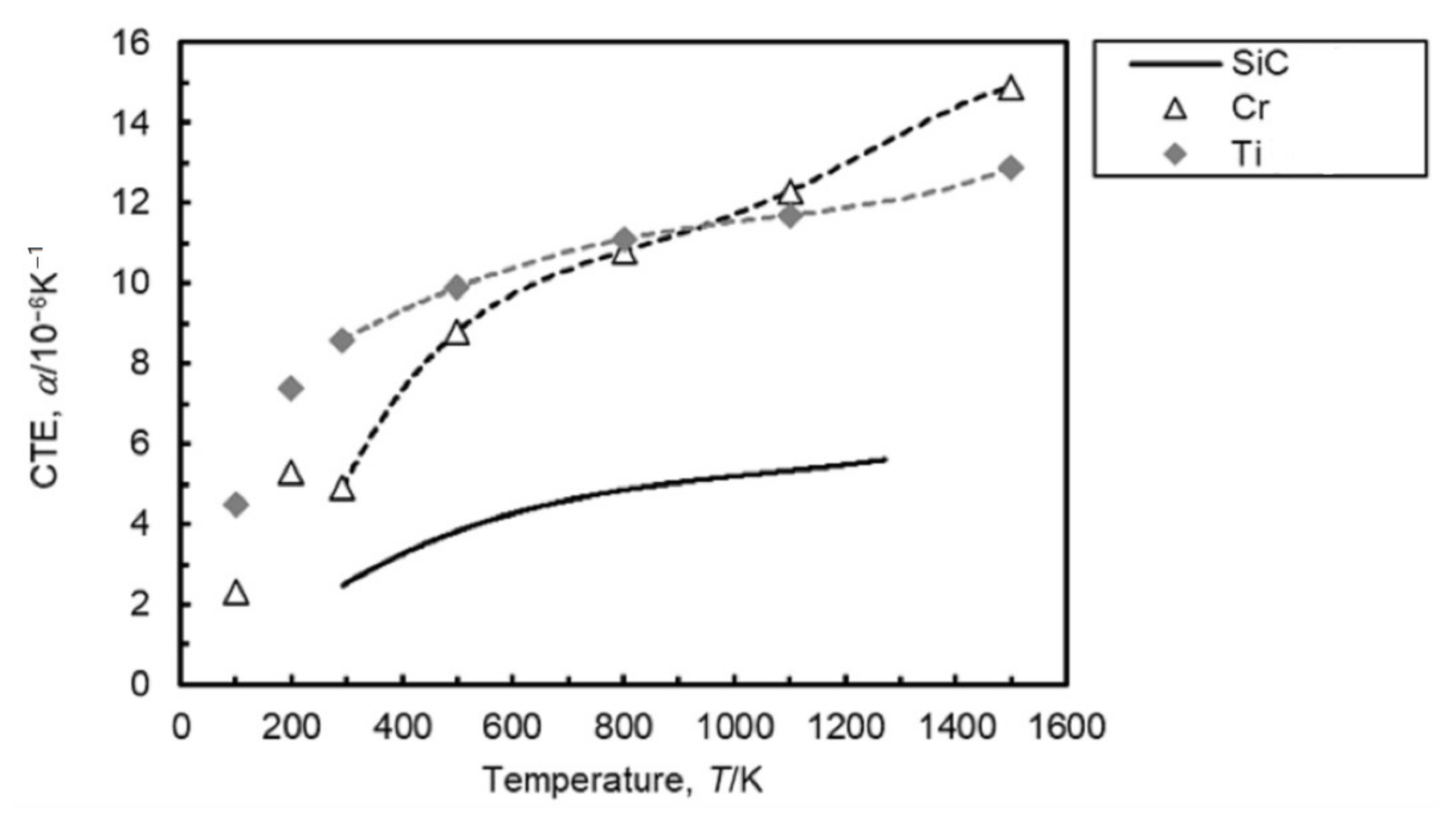

| Phase | Crystal System | Space Group | Lattice Constant | Database |
|---|---|---|---|---|
| α-Ti | Hexagonal | a = b = 0.4577 nm, c = 0.2829 nm, α = β = 90°, γ = 120° | The Materials Project *1 mp-72 [57] | |
| TiC | Cubic | a = b = c = 0.4336 nm, α = β = γ = 90° | The Materials Project *1 mp-631 [58] | |
| TiCr2 | Hexagonal | a = b = 0.4877 nm, c = 0.7868 nm, α = β = 90°, γ = 120° | The Materials Project *1 mp-1589 [59] | |
| Cr | Cubic | a = b = c = 0.2874 nm, α = β = γ = 90° | The Materials Project *1 mp-90 [60] | |
| Cr3Si | Cubic | a = b = c = 0.4519 nm, α = β = γ = 90° | The Materials Project *1 mp-729 [61] | |
| Cr5Si3 | Orthorhombic | a = 0.5543 nm, b = 0.8206 nm, c = 0.4179 nm, α = β = γ = 90° | AFLOW *2 Prototype A5B3_oC16_65_aeh_bj [62] | |
| SiC | Cubic | a = b = c = 0.4058 nm, α = β = γ = 90° | AFLOW *2 Prototype: AB_cF8_225_b_a [63] |
| Layer | Chemical Components by SEM-EDS [49] | Lattice Structure by EBSD [49] | Phase Identified by XRD [47,48,49] | Phase Identified by TEM-EDS and SAD Analysis (This Study) |
|---|---|---|---|---|
| Ti | Ti | α-Ti | α-Ti | α-Ti |
| Ti | BCC | β-Ti | - | |
| Ti and Cr | (Fairly low IQ *1) | TiCr2 | TiCr2 | |
| Ti and C | FCC | TiC | TiC | |
| Ti-Cr mixed | Ti and Cr | BCC | β-Ti | - |
| Ti and Cr | (Fairly low IQ *1) | TiCr2 | TiCr2 | |
| Ti and C | FCC | TiC | - | |
| Cr | Cr | BCC | Cr | Cr |
| Ti, Cr and O [grain boundary] | BCC | - | - | |
| Diffused Cr-SiC interface | Cr and Si (Cr-rich) | Cr3Si | - | Cr3Si |
| Cr, Si and C (Si-rich) | (Fairly low IQ *1) | - | Cr5Si3 or Cr5Si3Cx | |
| SiC | Si and C | FCC | - | β-SiC |
| Material | Irradiation | Temperature | Exposure | Microstructure | Swelling | Ref. |
|---|---|---|---|---|---|---|
| Pure Ti (bulk) | Neutrons | 423 K | 1.3 × 1024 n/m2 (E > 1 MeV) | Black spots | - | [70] |
| Neutrons | 723 K | 3 × 1025 n/m2 (E > 0.1 MeV) | Dislocation loops | - | [71] | |
| Neutrons | 673 K | 3.9 × 1023 n/m2 (E > 1 MeV) | Dislocation loops | - | [72] | |
| 6 MeV Ti2+ ions | 573 K | 0.6, 3 dpa | Black spots Dislocation loops | - | [73] | |
| 703 K | 0.6, 3 dpa | Dislocation loops | - | |||
| Cr coating | 1.4 MeV Ar ions | 673 K | 5, 15, 25 dpa | Void (1.5–4 nm) | 0.16% for 5 dpa *1 0.66% for 25 dpa *1 | [74] |
| Neutrons | 593–613 K | 4.8 × 1024 n/m2 (E > 0.1 MeV) ~0.5 dpa | Void (2 nm) | 0.2% *1 (~0.07% length change) | [43] | |
| Pure Cr (bulk) | 5 MeV Fe ions | 723 K | 50 dpa (peak) | Void (4 nm) | 0.5 % *1 | [75] |
Publisher’s Note: MDPI stays neutral with regard to jurisdictional claims in published maps and institutional affiliations. |
© 2022 by the authors. Licensee MDPI, Basel, Switzerland. This article is an open access article distributed under the terms and conditions of the Creative Commons Attribution (CC BY) license (https://creativecommons.org/licenses/by/4.0/).
Share and Cite
Ishibashi, R.; Hayashi, Y.; Bo, H.; Kondo, T.; Hinoki, T. Radiation Effect in Ti-Cr Multilayer-Coated Silicon Carbide under Silicon Ion Irradiation up to 3 dpa. Coatings 2022, 12, 832. https://doi.org/10.3390/coatings12060832
Ishibashi R, Hayashi Y, Bo H, Kondo T, Hinoki T. Radiation Effect in Ti-Cr Multilayer-Coated Silicon Carbide under Silicon Ion Irradiation up to 3 dpa. Coatings. 2022; 12(6):832. https://doi.org/10.3390/coatings12060832
Chicago/Turabian StyleIshibashi, Ryo, Yasunori Hayashi, Huang Bo, Takao Kondo, and Tatsuya Hinoki. 2022. "Radiation Effect in Ti-Cr Multilayer-Coated Silicon Carbide under Silicon Ion Irradiation up to 3 dpa" Coatings 12, no. 6: 832. https://doi.org/10.3390/coatings12060832
APA StyleIshibashi, R., Hayashi, Y., Bo, H., Kondo, T., & Hinoki, T. (2022). Radiation Effect in Ti-Cr Multilayer-Coated Silicon Carbide under Silicon Ion Irradiation up to 3 dpa. Coatings, 12(6), 832. https://doi.org/10.3390/coatings12060832






